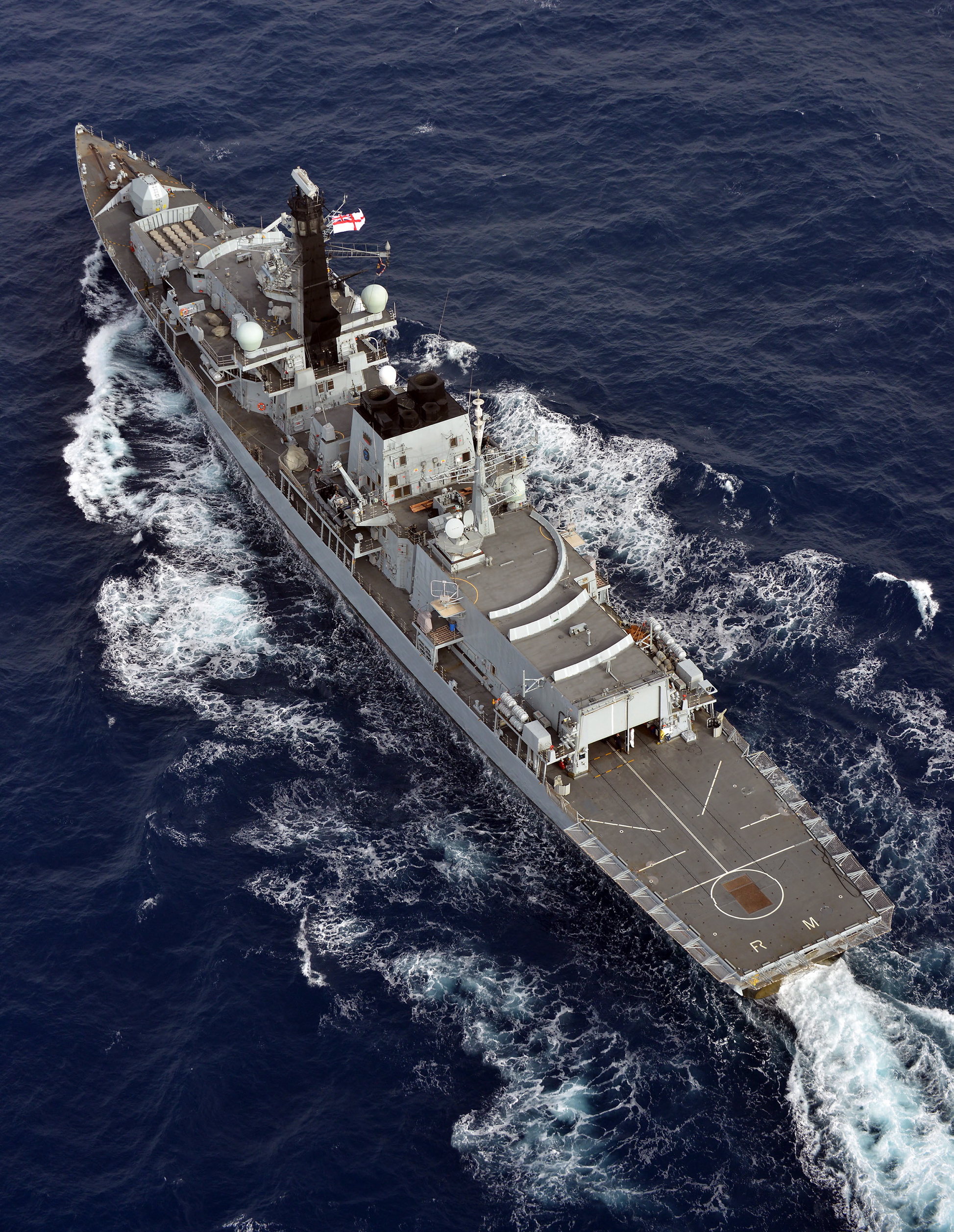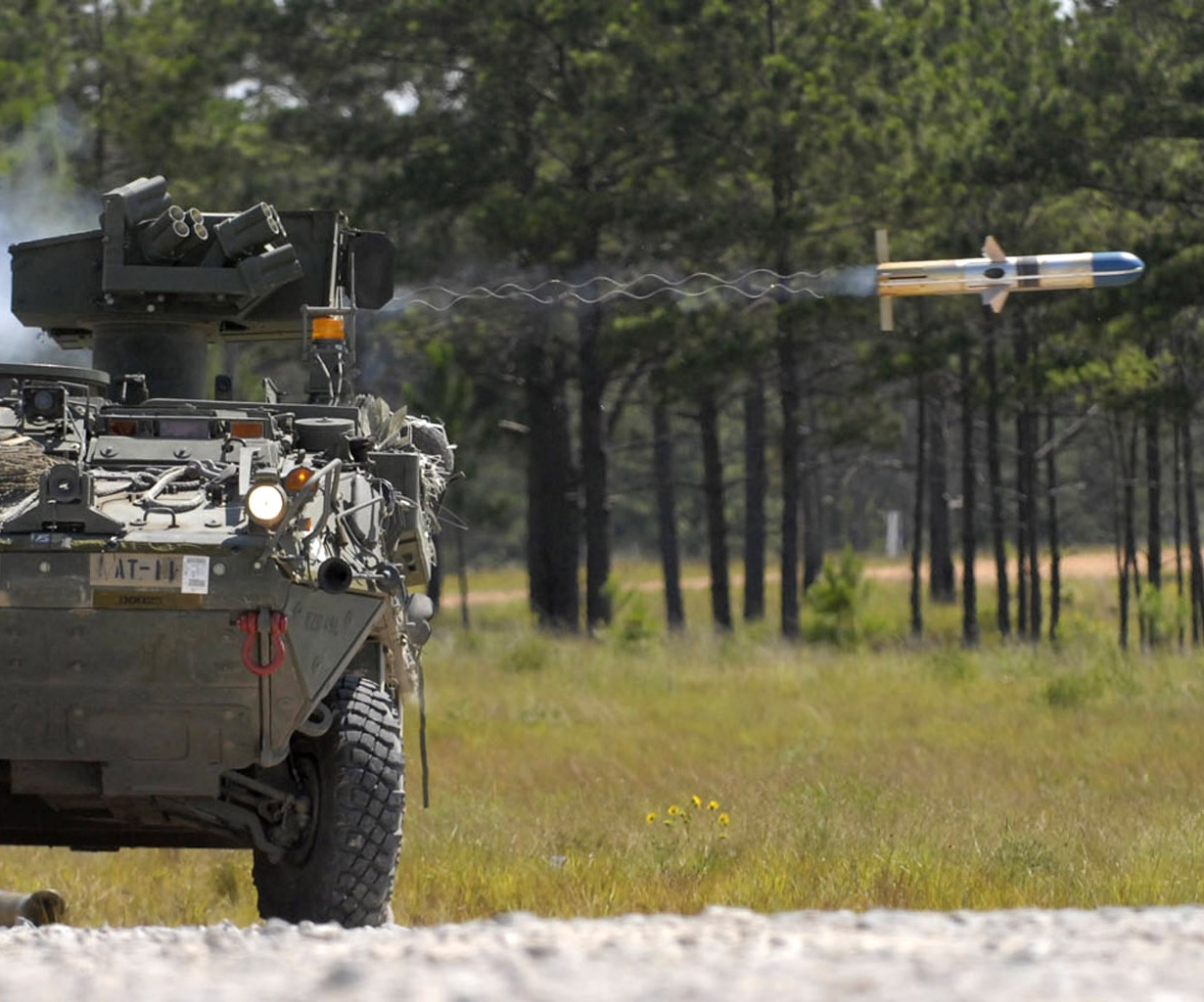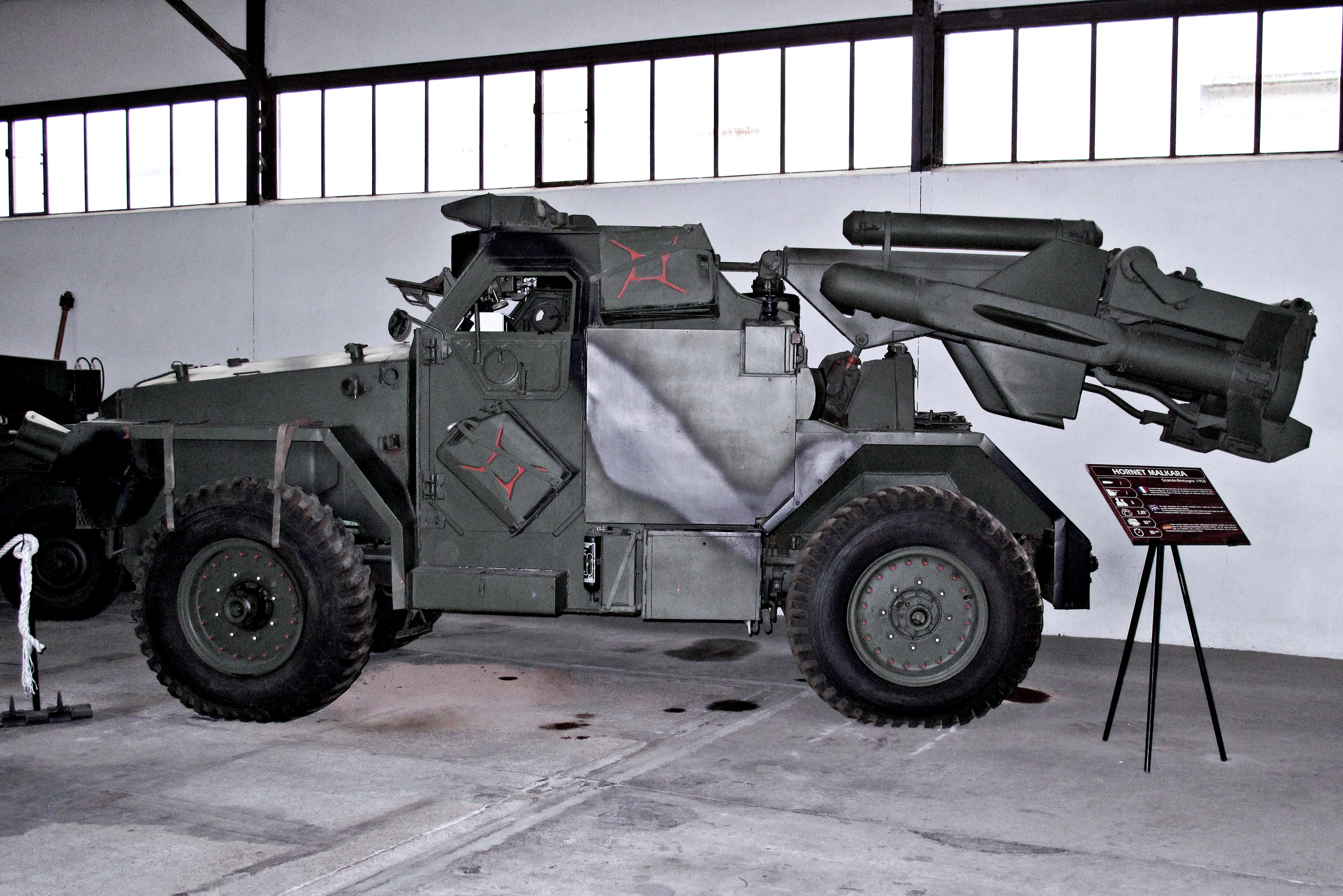|
Sea Wolf (missile)
Sea Wolf is a naval surface-to-air missile system designed and built by BAC, later to become British Aerospace (BAe) Dynamics, and now MBDA. It is an automated point-defence weapon system designed as a short-range defence against both sea-skimming and high angle anti-ship missiles and aircraft. The Royal Navy has fielded two versions, the GWS-25 Conventionally Launched Sea Wolf (CLSW) and the GWS-26 Vertically Launched Sea Wolf (VLSW) forms. In Royal Navy service Sea Wolf is being replaced by Sea Ceptor. History The earliest point-defence missile used by the Royal Navy was the Seacat, which had been rapidly developed from an earlier anti-tank missile design, the Malkara. As a weapon originally designed to operate against slow-moving ground vehicles, the missile had subsonic performance and was of limited capability against even early jet aircraft. It was used largely due to the ease which it could be adapted to the role simply by replacing the original wire guidance system with a ... [...More Info...] [...Related Items...] OR: [Wikipedia] [Google] [Baidu] |
Type 23 Frigate
The Type 23 frigate or Duke class is a class of frigates built for the United Kingdom's Royal Navy. The ships are named after British Dukes, thus leading to the class being commonly known as the Duke class. The first Type 23, , was commissioned in 1989, and the sixteenth, was commissioned in June 2002. They form the core of the Royal Navy's destroyer and frigate fleet and serve alongside the Type 45 destroyers. They were designed for anti-submarine warfare, but have been used for a range of uses. Twelve Type 23 frigates remain in service with the Royal Navy, with three vessels having been sold to the Chilean Navy, and one being retired in 2021. The Royal Navy's Type 23 frigates will be replaced by the Type 26 Global Combat Ship and the Type 31 frigate. it is anticipated that HMS ''St Albans'' will be the last to retire from the Royal Navy, in 2035. Development When first conceived in the late 1970s, the Type 23 was intended to be a light anti-submarine frigate with a towed ... [...More Info...] [...Related Items...] OR: [Wikipedia] [Google] [Baidu] |
Anti-ship Missile
An anti-ship missile (AShM) is a guided missile that is designed for use against ships and large boats. Most anti-ship missiles are of the sea skimming variety, and many use a combination of inertial guidance and active radar homing. A good number of other anti-ship missiles use infrared homing to follow the heat that is emitted by a ship; it is also possible for anti-ship missiles to be guided by radio command all the way. The first anti-ship missiles, which were developed and built by Nazi Germany, used radio command guidance.https://airandspace.si.edu/collection-objects/bomb-guided-fritz-x-x-1/nasm_A19840794000#:~:text=The%20Fritz%20X%2C%20also%20known,the%20Henschel%20Hs%20293%20missile. These saw some success in the Mediterranean Theatre during 1943–44, sinking or heavily damaging at least 31 ships with the Henschel Hs 293 and more than seven with the ''Fritz X'', including the Italian battleship ''Roma'' and the light cruiser . A variant of the HS 293 had a TV ca ... [...More Info...] [...Related Items...] OR: [Wikipedia] [Google] [Baidu] |
Sea Wolf Missile
The sea, connected as the world ocean or simply the ocean, is the body of water, body of saline water, salty water that covers approximately 71% of the Earth's surface. The word sea is also used to denote List of seas, second-order sections of the sea, such as the Mediterranean Sea, as well as certain large, entirely landlocked, saltwater lakes, such as the Caspian Sea. The sea moderates Earth's climate and has important roles in the water cycle, water, carbon cycle, carbon, and nitrogen cycle, nitrogen cycles. Humans harnessing and studying the sea have been recorded since ancient times, and evidenced well into prehistory, while its modern scientific study is called oceanography. The most abundant solid dissolved in seawater is sodium chloride. The water also contains salt (chemistry), salts of magnesium, calcium, potassium, and Mercury (element), mercury, amongst many other elements, some in minute concentrations. Salinity varies widely, being lower near the surface and the mo ... [...More Info...] [...Related Items...] OR: [Wikipedia] [Google] [Baidu] |
Loch-class Frigate
The Loch class was a class of anti-submarine (A/S) frigate built for the Royal Navy and her Allies during World War II. They were an innovative design based on the experience of three years of fighting in the Battle of the Atlantic and attendant technological advances. Some shipyards had trouble building these larger ships, which led to widespread use of the Castle-class corvette, introduced around the same time. Design The Lochs were based upon the hull of the preceding with increased sheer and flare to improve seakeeping and modified to suit it to mass pre-fabrication, with sections riveted or welded together at the shipyard. Accordingly, as many curves as possible were eliminated, producing a noticeable kink in the main deck where the increased sheer forwards met the level abreast the bridge. The fighting capability of the Loch class was a great jump forward, being based around the new Squid ahead-throwing A/S mortar. Previously, escorts had attacked with depth charges ... [...More Info...] [...Related Items...] OR: [Wikipedia] [Google] [Baidu] |
Leander-class Frigate
The ''Leander''-class, or Type 12I (Improved) frigates,Purvis, M.K., 'Post War RN Frigate and Guided Missile Destroyer Design 1944-1969', Transactions, Royal Institution of Naval Architects (RINA), 1974 comprising twenty-six vessels, was among the most numerous and long-lived classes of frigate in the Royal Navy's modern history. The class was built in three batches between 1959 and 1973. It had an unusually high public profile, due to the popular BBC television drama series ''Warship''. The ''Leander'' silhouette became synonymous with the Royal Navy through the 1960s until the 1980s. The ''Leander'' design or derivatives of it were built for other navies: *Royal New Zealand Navy as the ''Leander'' class *Chilean Navy: *Royal Australian Navy: *Indian Navy: *Royal Netherlands Navy: Design The policy adopted by the Royal Navy during the 1950s of acquiring separate types of frigates designed for specialised roles (i.e. anti-submarine, anti-aircraft and aircraft direction ... [...More Info...] [...Related Items...] OR: [Wikipedia] [Google] [Baidu] |
Vickers
Vickers was a British engineering company that existed from 1828 until 1999. It was formed in Sheffield as a steel foundry by Edward Vickers and his father-in-law, and soon became famous for casting church bells. The company went public in 1867, acquired more businesses, and began branching out into military hardware and shipbuilding. In 1911, the company expanded into aircraft manufacturer, aircraft manufacture and opened a flying school. They expanded even further into electrical and railway manufacturing, and in 1928 acquired an interest in the Supermarine. Beginning in the 1960s, various parts of the company were nationalised, and in 1999 the rest of the company was acquired by Rolls-Royce Holdings, Rolls-Royce plc, who sold the defence arm to Alvis plc. The Vickers name lived on in Alvis Vickers, until the latter was acquired by BAE Systems in 2004 to form BAE Systems Platforms & Services, BAE Systems Land Systems. History Early history Vickers was formed in Sheffield ... [...More Info...] [...Related Items...] OR: [Wikipedia] [Google] [Baidu] |
Bofors 40 Mm Automatic Gun L/60
The Bofors 40 mm Automatic Gun L/60 (often referred to simply as the "Bofors 40 mm gun", the "Bofors gun" and the like, see name) is an anti-aircraft autocannon, designed in the 1930s by the Swedish arms manufacturer AB Bofors. The gun was designed as an intermediate anti-aircraft gun, filling the gap between fast firing close-range small calibre anti-aircraft guns and slower firing long-range high calibre anti-aircraft guns, a role which previously was filled by older outdated guns. The Bofors 40 mm L/60 was for its time perfectly suited for this role and outperformed competing designs in the years leading up to World War II in both effectiveness and reliability. It entered the export market around 1932 and was in service with 18 countries by 1939. Throughout World War II it became one of the most popular and widespread medium-weight anti-aircraft guns. It was used by the majority of the western Allies and some Axis powers such as Nazi Germany and Hungary. In the pos ... [...More Info...] [...Related Items...] OR: [Wikipedia] [Google] [Baidu] |
Radio Command
Command guidance is a type of missile guidance in which a ground station or aircraft relay signals to a guided missile via radio control or through a wire connecting the missile to the launcher and tell the missile where to steer to intercept its target. This control may also command the missile to detonate, even if the missile has a fuze. Typically, the system giving the guidance commands is tracking both the target and the missile or missiles via radar. It determines the positions and velocities of a target and a missile, and calculates whether their paths will intersect. If not, the guidance system will relay commands to a missile, telling it to move the fins in a way that steers in the direction needed to maneuver to an intercept course with the target. If the target maneuvers, the guidance system can sense this and update the missiles' course continuously to counteract such maneuvering. If the missile passes close to the target, either its own proximity or contact fuze will d ... [...More Info...] [...Related Items...] OR: [Wikipedia] [Google] [Baidu] |
Wire Guidance
A wire-guided missile is a missile that is guided by signals sent to it via thin wires connected between the missile and its guidance mechanism, which is located somewhere near the launch site. As the missile flies, the wires are reeled out behind it (command guidance). This guidance system is most commonly used in anti-tank missiles, where its ability to be used in areas of limited line-of-sight make it useful, while the range limit imposed by the length of the wire is not a serious concern. The longest range wire-guided missiles in current use are limited to about . History Electrical wire guidance dates back to the early 20th century with an early example being the Lay Torpedo. A prototype ground-based electrical wire-guided torpedo was built by the Germans during World War II. The pair of deployed German guided air-delivered ordnance designs, the Fritz X and Henschel Hs 293, both used the ''Kehl-Straßburg'' radio guidance system for control. However, because the Briti ... [...More Info...] [...Related Items...] OR: [Wikipedia] [Google] [Baidu] |
Malkara (missile)
The Malkara (from an Aboriginal word for "shield") was one of the earliest guided anti-tank missiles (ATGMs). It was jointly developed by Australia and the United Kingdom between 1951 and 1954, and was in service from 1958 until gradually replaced by the Vickers Vigilant missile in the late 1960s. It was intended to be light enough to deploy with airborne forces, yet powerful enough to knock out any tank then in service. The basic form was later adapted for the short-range surface-to-air role as the Seacat and influenced the development of the Ikara. Development and operations Design was principally undertaken at the Australian Government Aeronautical Research Laboratory, and this phase was also one of the first examples of computer simulation in engineering design. Development testing was carried out at Woomera Prohibited Area, and approval testing at the tank training range at Lulworth Cove, Dorset. Although testing at Dorset apparently achieved an impressive 90% Pkill, in ser ... [...More Info...] [...Related Items...] OR: [Wikipedia] [Google] [Baidu] |
Anti-tank Missile
An anti-tank guided missile (ATGM), anti-tank missile, anti-tank guided weapon (ATGW) or anti-armor guided weapon is a Missile guidance, guided missile primarily designed to hit and destroy Armoured fighting vehicle, heavily armored military vehicles. ATGMs range in size from shoulder-launched weapons, which can be transported by a single soldier, to larger tripod-mounted weapons, which require a squad or team to transport and fire, to vehicle and aircraft mounted missile systems. Earlier man-portable anti-tank weapons like anti-tank rifles and magnetic anti-tank mines, generally had very short range, sometimes on the order of metres or tens of metres. Rocket-propelled high-explosive anti-tank (HEAT) systems appeared in World War II and extended range to the order of hundreds of metres, but accuracy was low and hitting targets at these ranges was largely a matter of luck. It was the combination of rocket propulsion and remote wire guidance that made the ATGM much more effective ... [...More Info...] [...Related Items...] OR: [Wikipedia] [Google] [Baidu] |
Seacat Missile
Seacat was a British short-range surface-to-air missile system intended to replace the ubiquitous Bofors 40 mm gun aboard warships of all sizes. It was the world's first operational shipboard point-defence missile system, and was designed so that the Bofors guns could be replaced with minimum modification to the recipient vessel and (originally) using existing fire-control systems. A mobile land-based version of the system was known as Tigercat. The initial GWS.20 version was manually controlled, in keeping with the need for a rapidly developed and deployed system. Several variants followed; GWS.21 added radar-cued manual control for night and bad-weather use, GWS.22 added a SACLOS automatic guidance mode, and the final GWS.24 had fully automatic engagement. Tigercat saw relatively brief service before being replaced in British service by the Rapier, while Seacat saw longer service until being replaced by Sea Wolf and newer technology close-in weapons systems. Seacat and Tigerc ... [...More Info...] [...Related Items...] OR: [Wikipedia] [Google] [Baidu] |

.jpg)

.png)





